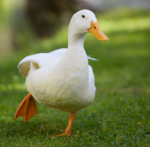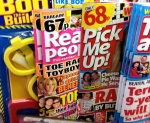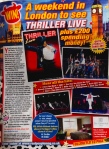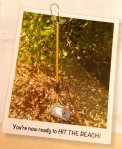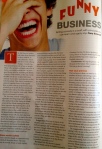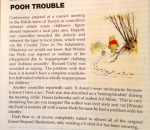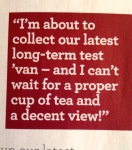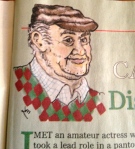Tagline: ‘Ameri—(Bruce Jenner’s head)–ttest weekly’
Price: £1
Who is this magazine for? Being a celebrity is a popular career choice for some people. Apparently it’s supposed to be a glorious release from the drudgeries of life. No more sorting out the recycling or hanging around with mouth-breathers. No more Youngs Admiral’s Pie. No more exams or beige carpet. It’s all red, red, red from here baby.
But these dream jobs often turn out to be hard in ways you wouldn’t imagine. Guns ‘N’ Roses whiner Axl Rose once pointed out that the life of a rock and roll front man wasn’t so fun when you had to do the business every day. ‘Would you want to jump off a car roof every night?’ he bitches, a routine which puts a twice-daily Jubilee Line crush into perspective.
Another occupational hazard of celebrity life is the gossip rags. These are essentially toilet roll for wiping the minds of the terminally confused. From the price tag to the shoddy, absorbent paper, National Enquirer does all it can to create the impression that this is a publication run and read by bin-sifters.
National Enquirer is written for the American market. This fact is given away by three things – Old Glory on the masthead, repeated and unapologetic use of the word ‘duds’, and a laser-like focus on Hollywood’s finest. British gossip-mongers like Heat and Pick Me Up! tend to shy away from A-listers. That’s partly because they have neither the PR contacts nor the libel insurance to risk it, and partly because their readerships prefer to pass judgment on whoever happens to be on Hollyoaks or Corrie this week. I suppose if you’re going to shit on people, far better to be close enough to them to imagine the look on their faces.
What did you get for your £1? National Enquirer focuses on targets (and I use that word advisedly) who have achieved single name recognition. In most cases – ‘Britney’, ‘Kanye’, ‘Brad’ – this represents ultimate accolade of public life. Of course, single name recognition isn’t a guaranteed victory in every case. Lembit, for example.
But with a retail price of just a quid, it’s quite clear that National Enquirer is not going to be able to afford legitimate access to star quality of such lofty heights. Instead, you’re served the reheated remnants of the papparazzi’s more desperate efforts. This menu is set pitch perfectly by the inside front page: Britney Spears’ fat rolls captured by long lens, and Brooke Shields putting some dogshit in a bin.
Celebrity ‘news’ absorbs the vast majority of the mag’s 47 pages, but as an afterthought National Enquirer has generously thrown in a couple of pages of Real Life (usually some outlandish sex thing that would get seven or eight pages at the front if a bona fide celebrity did it) and True Crime (because National Enquirer is read by the kind of people that would slow down extravagantly at car accidents).
Features: After the dogshit-fat roll opener, the magazine gathers pace with the scoop that Rihanna is no longer planning on allegedly touring with Kanye. Hot on the heels of this ‘something unannounced isn’t going to happen’ shocker, National Enquirer follows up with ‘something that happened on TV happened’, ‘something that’s going to happen on TV will happen’, and then, brilliantly, another story about dogshit.
Unfortunately, other than excreta-based exclusives, the mag’s cupboard of fresh stories is distinctly bare. A twenty-year old story about Demi Moore is followed up by the stunning revelation that time continues to pass, with reports suggesting this temporal phenomena is especially pronounced in the vicinity of Michael Douglas’ face.

It’s a cheap gag, but seeing as she’s made a very lucrative career by making women feel inadequate, I don’t care.
Some originality is provided by the liposuction photo feature, which elegantly kills two shitehawks with one stone by allowing the mag to print bikini-clad celebs and judge them for being fat AND not being fat. It’s really not worth saying anything more about this, other than the fact the Donatella Versace bears a striking resemblance to an oven-baked version of the Javier Bardem bad guy in Skyfall.
Meanwhile, over in True Crime, we have the story of a woman who killed her husband for his money before keeping his remains in Tupperware boxes for seven years. She even moved house twice. Clearly this is both sinister and sad, but the horror of the crime is dampened somewhat by National Enquirer’s ecstatic praise for Tupperware’s ‘handy, leak-proof containers with snap-on lids’. This is either an exceptionally poor investment of the Tupperware PR budget, or a savvy grab for the sizeable ‘well, you’ll never know when you might need it’ murderer’s Tupperware party market.
Adverts: Surprisingly, the mag has only managed to snag two adverts. The first is for Peacocks, a clothing chain that competes with, nay, aspires to be Primark.
The second, on the back cover, is for a Nightmare Before Christmas themed clock. A tenner for ‘S&H’, and a further £179.95 for the ‘I&T’ that is the clock itself, this 21-inch monstrosity must be the ugliest object ever crafted by human hands. Looking at it directly produces a burning sensation akin to being stung repeatedly in the eye by a swarm of urine-soaked bees. Legislation prevents me from publishing a photo.
Magazine favourites The Bradford Exchange are behind it, of course, rubbing their hairy hands with glee. For some reason, I can’t shake the feeling that David Blaine must be a shareholder in them.
Letters page: National Enquirer doesn’t have a letters page. However, that doesn’t mean it takes no interest in what the readers are thinking. There was a comprehensive survey at the back, so I helpfully decided to fill it in.
Hopefully I’ll get the 100 quid.
Rating: 2/10
Provided they stick to Tupperware and dogshit, National Enquirer is almost readable. Otherwise, no.
Enjoyed this rubbish? Why not follow Toilet Reading on Twitter.







